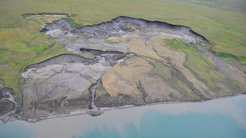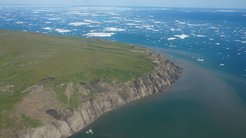The current state of the Arctic carbon cycle
New study on the Arctic carbon cycle provides important insights and highlights research needs
The Arctic plays a central role in the global climate system, particularly through its function as a carbon sink. However, climate change could disrupt its balance. An international research team headed by the Alfred Wegener Institute and the Vrije Universiteit Amsterdam has presented a comprehensive analysis of the current state of the Arctic carbon cycle. The results, which have been published in the scientific journal Nature Reviews Earth & Environment, provide new and updated numbers and highlight existing uncertainties.
This press release was kindly provided by the Alfred Wegener Institute for Polar and Marine Research.

The land and water masses of the Arctic store considerable amounts of carbon. However, climatic changes are increasingly affecting stocks, fluxes and cycles of carbon, with potential consequences for ecosystems and the global climate. Previous reviews on this topic are more than 15 years old and do not take into account the rapid warming of the last 10 years. In order to better understand current and future developments, researchers led by the Alfred Wegener Institute, Helmholtz Centre for Polar and Marine Research (AWI) and the Vrije Universiteit Amsterdam. Scientists from the Max Planck Institute for Biogeochemistry also contributed to the study. This analysis not only shows current numbers on the Arctic carbon budget, but also identifies existing knowledge gaps and research needs.
Arctic carbon storage under pressure
The new overview is based on data from international studies and the European permafrost research project NUNATARYUK (2017-2023), which has compiled extensive information on the Arctic carbon cycle. “26 partner institutions from 12 countries worked together to understand how thawing permafrost on land, along the coast and under the sea affects the global climate and life in the Arctic,” explains Dr Michael Fritz, co-first author of the study and geoscientist at the AWI.
The analysis shows that the Arctic in its entirety is still a carbon sink. “The Arctic Ocean stores more than 100 million tons of CO2 from the atmosphere every year,” explains Dr Jorien Vonk from the Vrije Universiteit Amsterdam, co-first author of the study. “The land masses also continue to bind carbon, but with decreasing capacity. Thawing permafrost, forest fires and soil erosion in particular could lead to a net carbon source in the long term.” In addition, Arctic inland waters, such as rivers and lakes, are already emitting significant amounts of CO2 and methane.
New findings and future research needs – international cooperation for a better understanding
The study provides comprehensive information on
- how much carbon is stored in Arctic soils, in the seafloor and in the water column of the Arctic Ocean,
- how much carbon is released into the Arctic Ocean through coastal erosion and rivers,
- and where greenhouse gases are stored or produced.

However, numerous research questions still need to be answered in order to further reduce the uncertainties in the Arctic carbon cycle. “We need to focus more on small northern river drainage areas and coastal regions, as climate change has a particularly strong impact there,” says Michael Fritz. In addition, short-term and extreme events such as forest fires or heatwaves should be investigated more intensively.
In order to be able to make reliable predictions about the future development of the Arctic as a carbon sink or source, further international research efforts are required on a large scale. “We must explain the scientific complexity in an understandable way so that politicians and society can make informed decisions,” emphasizes Jorien Vonk. “Only if we understand the interaction of the individual components in the Arctic carbon cycle in terms of how they function and their vulnerability to climate change, we can make reliable statements about the future of the Arctic as a carbon sink or carbon source,” summarizes Michael Fritz.













